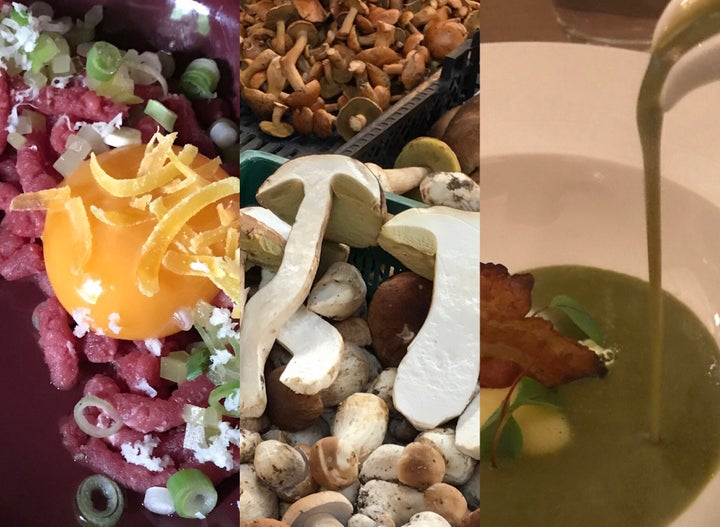
Tartare at Jadka, Wrocław; Seasonal mushrooms; Sorrel soup at A Nóż Widelec, Poznań
What is Polish cuisine? One year ago I traveled to Poland for my first exploration of its food and culinary traditions. I was both surprised and intrigued by the vitality of the whole sector, the quality of ingredients, the works of producers, and the creativity of chefs. I was so captivated by what I saw that I kept going back, most recently in a culinary trip to Warsaw and the Western cities of Poznań and Wrocław organized by the Polish Cultural Institute in NYC and Polish Plate.
A few visits later, and with a better (although not extensive enough) knowledge of the culinary scene in the country, I realized how unusually urgent the question about what is Polish cuisine seems to have become. I have had the opportunity to sit on panels, participate in public and private debates, and serve as a judge in competitions focusing on specialties ranging from nalewki (the local spirits made by steeping fruits, wild berries, and other ingredients in alcohol) to czernina (a soup that features duck blood) and stuffed goose. The conversations often veered towards the very nature Polish cuisine and what makes it unique and distinctive.
It is ingredients? Dishes? Specific habits and traditions? Or it is rather a question of who produces and prepares what is eaten? Is it necessary to dig back into the near and remote past to identify specific customs and flavors profiles, or should one stick to contemporary practices? The answers to these questions run the gamut from the desire to find essential (and unchanging) characteristics to a more nuanced appreciation for the recent resurgence of food in Poland in terms of quality, visibility, and relevance in public discourse.
As a scholar in food studies, participating in these conversations has prompted other, maybe more reflexive (more “meta,” as we like to say when we use jargon), questions: why are all sorts of stakeholders in the food system discussing what is Polish food? Why now? What are the motivations and the goals of such discussions? Are these topics of interest to large segments of Poles, or are they rather the exclusive domain of producers and other actors on the culinary scene, from chefs to media and tourist operators?
There is definitely a widespread interest about reconnecting (“rediscovering” is often the preferred expression) with local and traditional ingredients and dishes that are at times perceived as threatened by globalization and the growing popularity of foreign foods, at times experienced as unfortunately left aside because considered too rustic, or backward, or plain. Sitting in fine-dining restaurants such as Dom Wódki Elixir in Warsaw, Toga and A Nóż Widelec in Poznań, or Jadka in Wrocław you have the impression that traditional elements are already successfully integrated in modern, current culinary styles that can definitely hold their own on the international stage. Enterprises such as Pszczelarium and Nalewki Staropolskie (arguably the most recognizable nalewka production in Poland) in Warsaw, or Folwark Wąsowo and the carp ponds of Stawy Milickie in Lower Silesia, all appear to seamlessly connect past and present, merging old techniques and know-how with modern distribution and marketing savvy.
It is not easy to pinpoint the origins of this renewed interest in defining Polish food and in appreciating local and traditional ingredients and dishes. In part, Poland is reflecting a global trend among the rising middle-classes in post-industrial societies, for whom food has emerged as an important area in the formation, negotiation, and performance of individual and collective identities. As Poland transitions out of its post-communist phase and into a more mature – although not less troubled – political landscape, and consumerism in embraced as the standard lifestyle, food plays an increasingly relevant role in defining the cultural outlook, social status, and political worldviews of citizens from all walks of life.
This growing importance and visibility of food manifests itself in the success of culinary shows and media, also among the large majority of Poles that otherwise may go to restaurants only rarely and think twice before purchasing an expensive product. Among the middle-class, especially in urban environments and the younger generations, such relevance reveals the characteristics of what we could call “global foodie cosmopolitanism,” which expresses itself – in Warsaw as in Brooklyn, Rio de Janeiro or Bangalore - through specific sensory aesthetics in terms of flavors, dish presentation, environments (bar, restaurants, cafes), packaging, performance of preparation, service, and consumption. Heavily tinged in hipster undertones, this cosmopolitanism also supports the appreciation for local and traditional culinary elements that are globally hailed as a form of resistance to globalization, transnational corporations, and environmental disaster.
At the same time, Poland is inevitably dealing with the complexities deriving the presence along its history of various communities in the territory that now falls under Poland: Germans, Ukrainians, and Lithuanians just to mention a few. Such intricate past – which will come to the forefront in 2018 on the occasion of the 100-year anniversary of the formation of contemporary Poland as an independent nation-state - is also heightened by the presence of different religions (Catholic, Protestants, Jews) at different points in time. Moreover, some culinary traditions, while felt as quintessentially Polish, are similar to those in neighboring countries. As a consequence of all this, should we speak of Polish cuisine, or rather of the cuisines (in the plural) in Poland? And how would these two different approaches to thinking about Polish food fly in the present cultural and political climate?
